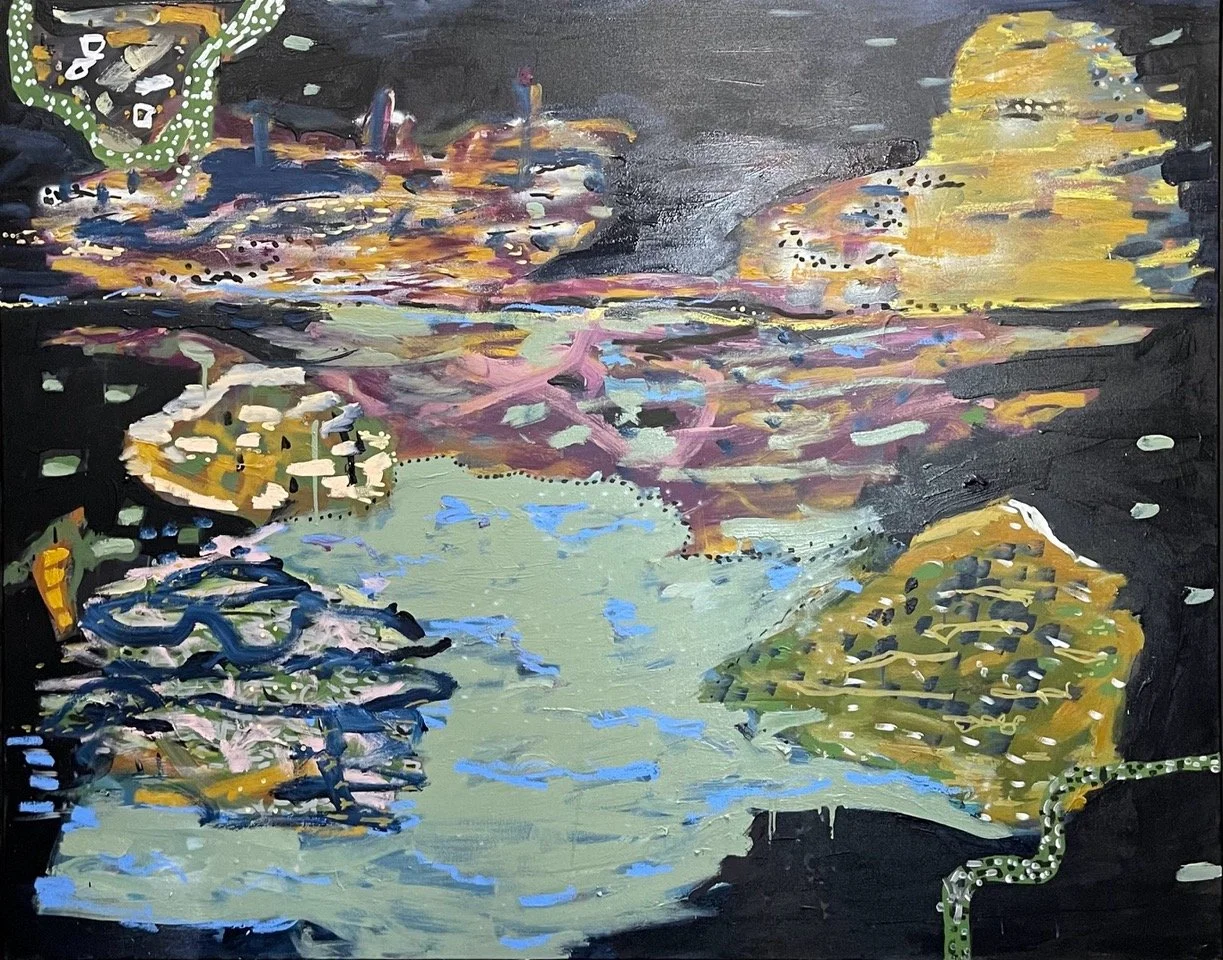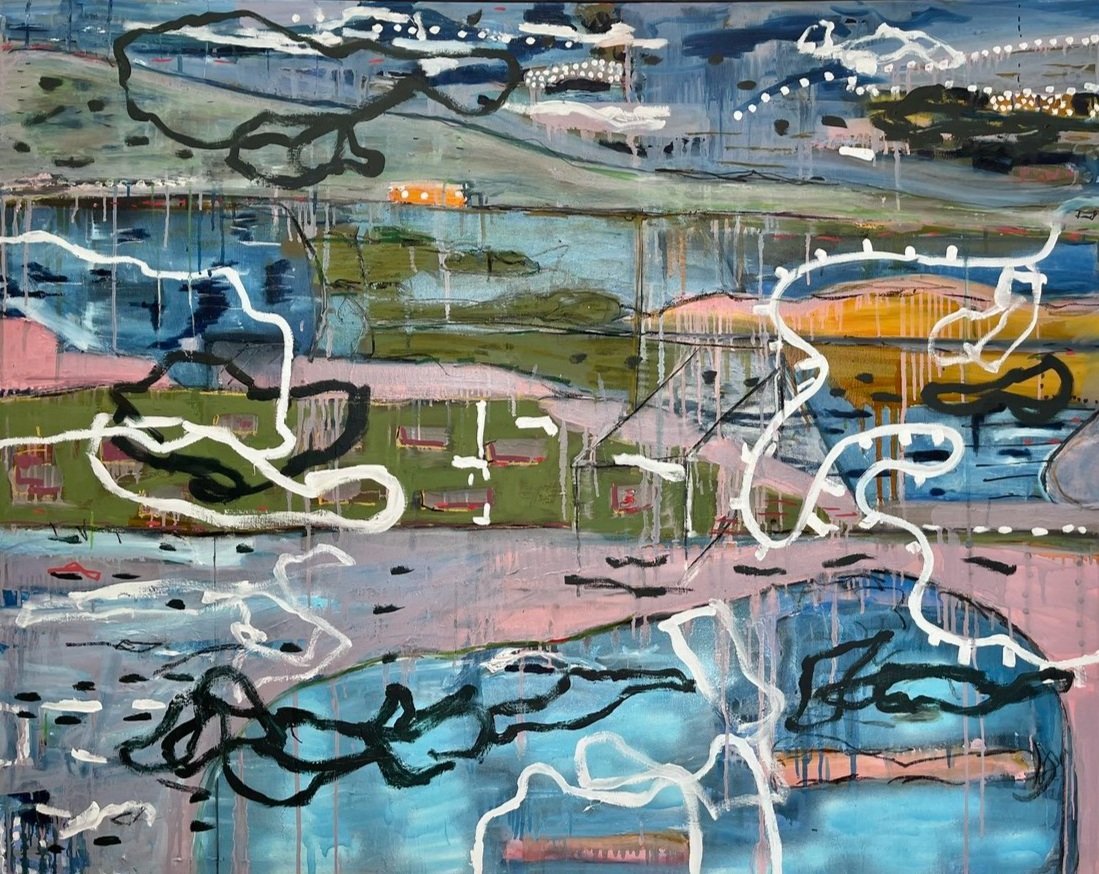Interview
Nathan Feldman
While the natural world plays a profound role in Feldman’s work, he maintains a delicate balance in its portrayal between abstraction and nostalgic memory. Within that world, the Australian landscape is the subject of inquiry – not a realistic depiction but that of a collection of memories; of sounds, smells and color.
Enigmatic, distorted images of rivers and creeks emerge from the landscape, while the colors and textures of the Australian bush speak of the ever changing environment. These organic forms converge to form a dynamic ecosystem, nature’s cycle of life, death and regeneration. Feldman’s approach is not to literally depict these elements, but to transform them, interweaving images into rich, magical, dreamlike environments filled with the perception of water, light and color.
Nathan Feldman was born in Geelong, Australia in 1974. He studied Fine Art at Monash University, receiving some of the last traditional tuition by some of Australia’s best realist painters. Feldman has exhibited widely in both Australia and overseas and his work is held in many private and corporate collections.
What is your background and how did you start your journey in the art world?
“My name is Nathan Feldman and I was born in Geelong, Australia in 1974. As a child I was always inspired by everyday sights: the cracks in tiles, layers of cracked paint and shadows thrown by the lace curtains in my childhood home. I spent a considerable amount of time in the Australian bush, and loved the way that dappled light filtered through the eucalyptus leaves and spread across the forest floor. There was a smell that as an adult I can no longer smell, but I recall it as the most raw and pure sensation, to draw the unpolluted, oxygen rich air into my lungs.
I remember entering the Otways National Park in the 80’s and winding down the back window of our families old clapped out station wagon and sticking my head out as far as I could. I let the cold wind rip into my skin and immersed myself in the sunlight as it flashed dots of yellow and lines of green and white into my eyes. I gave in to the psychedelic experience of travelling at 100km an hour with my head out the window, until my father who was driving informed me that people often got their heads ripped off when they stuck them out of a moving car window. At the time I thought that this wasn’t necessarily an unfair trade off. The natural environment seemed more like God than the version that my Evangelical Christian parents taught me. This spirituality of the land and the contrast with the man made is something that I try to capture in my current practice.
When I was 15 years of age, I was asked to leave school because I wasn’t doing any work except art and ceramics, which I had dedicated myself solely to, and it came at the expense of Mathematics, English and my other subjects. I now found myself with a lot of time on my hands, so as well as taking up smoking, I turned my garage into a studio and began to imitate artists like Roger Kemp, Leon Kossoff, Georges Rouault and Jean Dubuffet. I hung my work in local cafes and gave many away to people that expressed any interest in them. When you don’t attend school as a teenager and don’t have a formal job you start to form friendships with other young people who are also at a loose end. As a result of my new friendships and my journey towards delinquency, my mother told me that I either had to get a job or do some further study. I enrolled at The Geelong Fine Art School and spent 4 years under the tutelage of Robert Drummond. Robert was the first person to teach the importance of drawing and technical skills in applying paint and other mediums. He also taught me to speak out about injustice and to use art as a medium of communication.
I then went to study Fine Art at Monash University, majoring in Painting and Printmaking, and later studied Sociology and completed a postgraduate degree in education.”
What would you say inspires you most?
“I am inspired by the natural world and the Australian landscape, but am also inspired by the everyday - the person in the street, music, sounds, nostalgic memories and the construct of spirituality. I spent the first 10 years after I graduated from art school painting mainly religious themes that were exploring evangelical Christianity and questioning the relevance and the way in which society just accepts the truth of these narratives without question.”
“I ended up being disillusioned with the art system and trying to make relevant work for an audience. I eventually just stopped what I was doing, and focused on making paintings that expressed my true self and the sense of spirituality that comes from the land and landscape.”
What themes do you pursue? Is there an underlying message in your work?
“I see the landscape as a metaphor rather than a 3 dimensional thing that we exist in. I am particularly interested in the spirit of the land and in the space that it inhabits. The space that exists between things also interests me. For example, the space between night and day, the space where humans go before they are born and after they are dead, joy and suffering and good and evil.
My friend went to a funeral in the outback of Western Australia and he told me the funeral was this mix of Christianity and old traditions. Everyone was wearing suits and dresses and singing hymns that had been taught by colonial missionaries, as well as ancient traditions that went back millennia. I was interested in that space where those two things met. I dance the difficult dance of representing my own creative vision, without cultural appropriation.
I think my work is influenced by suffering, joy, love, kindness and pain - all those human things that we experience and endure.”
“I have certain political messages in my work, but chose to make them obscure and somewhat hidden from the viewer. I am particularly influenced by the stories of the Australian First Nations people and the injustice and generational trauma that they have suffered. The concept of the Dreamtime resonates deeply with my own spiritual connection found in the land, and I suppose that idea of the in-between space is that space between black and white, traditional cultural and Anglo-Christian.”
Which artists influence you most?
“I am influenced by so many different artists - they all play a part in my kind of mental library of mark making and use of colour. I like some work because of the narrative, I love some French Romanticism (works by Gericault are a great example of this). I have been influenced by Australian painters such as Roger Kemp, Ian Fairweather, Tony Tuckson, Jenny Watson, Davida Allen, Gareth Sampson and Imants Tillers.
I like the mark making of Cy Twombly, and the misty colours and relationships that are formed in the works of Milton Avery. Robert Motherwells’ mark making as well as Per Kirkeby for his mark making that sits somewhere between order and chaos. Edward Hopper, Jackson Pollock, Ernst Kirchner, Philip Guston, Helen Frankenthaler, Helene Schjerfbeck and the photography of Nobuyoshi Araki and Izima Kaoru are all artists that inspire me.
I enjoy the work of many outsider artists and was initially drawn to the work of Jean Dubuffet, but I am now more influenced by American outsider art like Sam Doyle’s ‘Old Hag’.”
How would you describe your work?
“I generally work on a fairly large scale and use a variety of mixed media, although I usually end up finishing my paintings in traditional oil paint. My work has been described as intuitive, which is true, but I often have something in mind when I start a painting. I sometimes have a dream or a kind of vision of what I want to create, and then go about trying to capture the essence of that. I enjoy the process of trial and error and risk taking, and love the action of painting itself. I try to let the process just happen and see where it takes me. I like dripping paint, and rubbing back areas and re-working them. I often paint over large areas of a painting. I also like to add text and use charcoal, spray paint and markers over and under the paint.”
What is your creative process like?
“I paint nearly everyday and work from a studio in the backyard of my house. I have been able to now dedicate my days to painting full time, and this allows me to be quite a prolific creator. I paint on average 70-80 works a year. I work in quite a bit of a mess and usually have an array of artworks on the go at once. I build paintings up in layers, and often each layer takes time to dry, so I start a few and then rotate between them. I start my days painting in silence but always end the day by playing old records as I work. I drink a lot of tea throughout the day too. I work mainly from memory but sometimes I take photos of places or things, so that I can remember them to use later. I do some small works on paper when starting a new series just to get the feel of things, and how they will work on a larger scale.”
What is an artist’s role in society and how do you see that evolving?
“Art is a funny thing, it’s everything but also nothing. Art once was used to communicate to the peasant class who were usually illiterate. Art conveyed an important cultural or religious message. We now live in an age of mass media that delivers every type of message in overdrive, regardless if we ask for or need it. The artist is lost in all this noise and the message, if any, is watered down and lost due to the competing static. This being said, there is still room among all that noise and jostling for attention for art and the artist. There is always room for beauty and sadness, and for love and contempt; for the punch in the guts that good art gives the viewer. It might not change the world but what would the world be like without it?”
Have you had any noteworthy exhibitions you'd like to share?
“Since I dropped all of my galleries bar one, I haven't had a solo show for about 7 years. I am working towards a major solo show in 2022. I enjoy representing myself and have been able to paint full time, which is great.”
Instagram: @nathanfeldmanart










